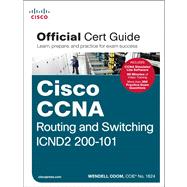Cisco Press is the official publisher for the New CCNA Routing and Switching Certification. The New Edition of this Best-Selling Official Cert Guide includes Updated Content, New Exercises, Enhanced Practice Exams, and 60 Minutes of Video Training -- PLUS the CCNA Network Simulator Lite Edition with lab exercises.
Cisco CCNA Routing and Switching ICND2 200-101 Official Cert Guide from Cisco Press enables you to succeed on the exam the first time. Best-selling author and expert instructor Wendell Odom shares preparation hints and test-taking tips, helping you identify areas of weakness and improve both your conceptual knowledge and hands-on skills.
This complete study package includes
- A test-preparation routine proven to help you pass the exams
- Do I Know This Already? quizzes, which enable you to decide how much time you need to spend on each section
- Chapter-ending and part-ending exercises, which help you drill on key concepts you must know thoroughly
- Troubleshooting sections, which help you master the complex scenarios you will face on the exam
- The powerful Pearson IT Certification Practice Test software, complete with hundreds of well-reviewed, exam-realistic questions, customization options, and detailed performance reports
- A free copy of the CCNA ICND2 200-101 Network Simulator Lite software, complete with meaningful lab exercises that help you hone your hands-on skills with the command-line interface for routers and switches
- More than 60 minutes of video mentoring from the author
- A final preparation chapter, which guides you through tools and resources to help you craft your review and test-taking strategies
- Study plan suggestions and templates to help you organize and optimize your study time
The official study guide helps you master all the topics on the CCNA exam, including
- Spanning Tree Protocol (STP)
- Troubleshooting LAN switching
- IPv4 routing
- VPNs
- OSPF and EIGRP configuration and troubleshooting
- Wide area networks and Frame Relay
- IPv6 implementation and troubleshooting
- Network management
Well regarded for its level of detail, study plans, assessment features, challenging review questions and exercises, video instruction, and hands-on labs, this official study guide helps you master the concepts and techniques that ensure your exam success.
Companion DVD
The DVD contains more than 350 unique practice exam questions, two complete ICND2 practice
exams and two full CCNA practice exams, ICND2 Network Simulator Lite software, and 60 minutes of video training.
Includes Exclusive Offer for 70% Off Premium Edition eBook and Practice Test
Pearson IT Certification Practice Test minimum system requirements:
Windows XP (SP3), Windows Vista (SP2), Windows 7, or Windows 8; Microsoft .NET Framework 4.0 Client; Pentium class 1GHz processor (or equivalent); 512 MB RAM; 650 MB disc space plus 50 MB for each downloaded practice exam.
CCENT ICND1 Network Simulator Lite minimum system requirements:
- Microsoft Windows XP (SP3), Windows Vista (32-bit/64-bit) with SP1, Windows 7 (32-bit/64-bit) or Windows 8 (32-bit/64-bit, x86 processors), Mac OS X 10.6, 10.7, or 10.8
- Intel Pentium III 1GHz or faster processor
- 512 MB RAM (1GB recommended)
- 1 GB hard disk space
- 32-bit color depth at 1024x768 resolution
- Adobe Acrobat Reader version 8 and above
Other applications installed during installation:
- Adobe AIR 3.6.0
- Captive JRE 6
This volume is part of the Official Cert Guide series from Cisco Press. Books in this series provide officially developed exam preparation materials that offer assessment, review, and practice to help Cisco Career Certification candidates identify weaknesses, concentrate their study efforts, and enhance their confidence as exam day nears.
The 1 hour 14 minute presentation found at the following link was given by Wendell Odom to cover “Teaching the New CCENT ICND1 100-101 & CCNA ICND2 200-101 Exam Material.” http://bit.ly/OdomCCENTCCNA








